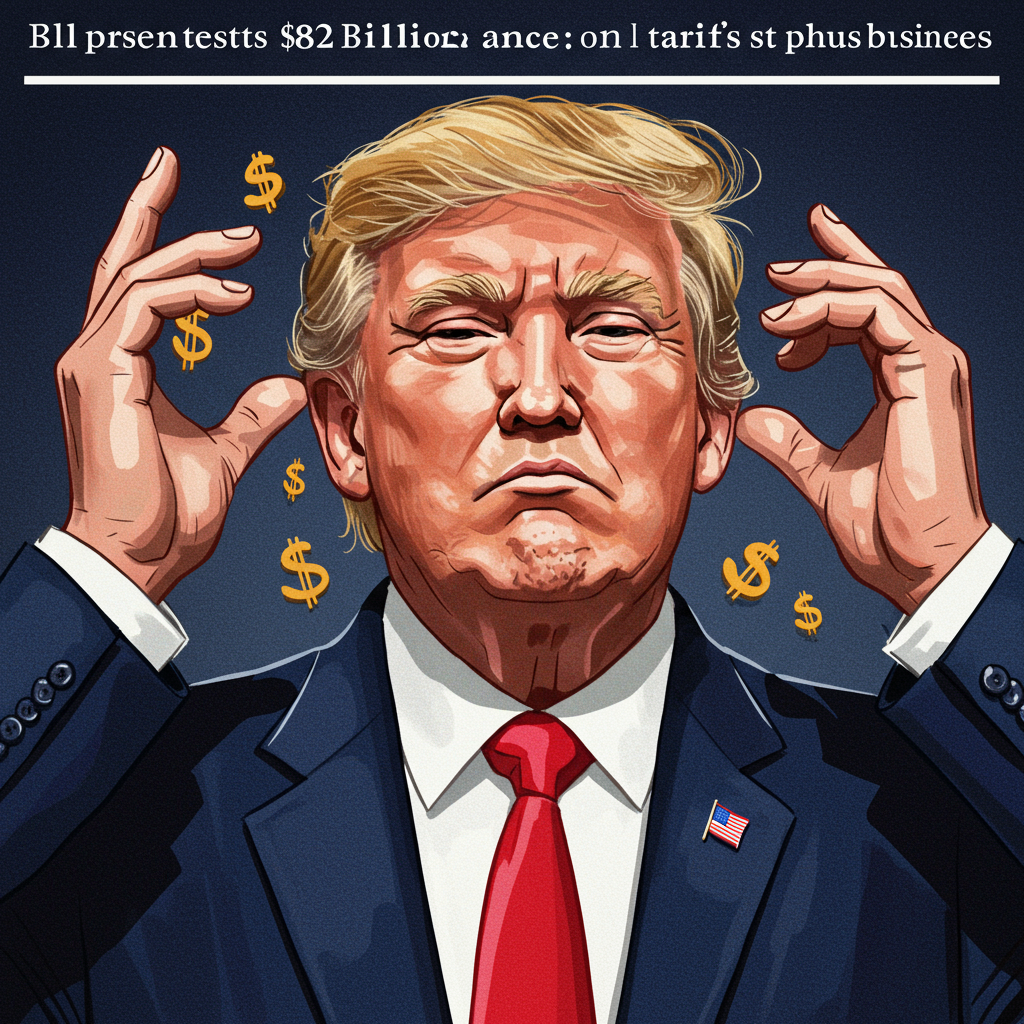A groundbreaking analysis reveals President Donald Trump’s tariffs inflict a substantial direct cost on a critical segment of U.S. employers. This key group faces an $82.3 billion burden under current import tax plans. Businesses may absorb this cost through various challenging measures. These include raising prices for customers, implementing layoffs, freezing hiring efforts, or simply accepting significantly lower profit margins. The findings challenge earlier assertions that foreign producers would bear the primary financial weight of these trade measures.
Quantifying the tariff Impact on US Companies
The analysis comes from the reputable JPMorganChase Institute. It is among the first detailed studies to quantify the direct financial impact of import taxes. The focus is specifically on businesses with annual revenues ranging from $10 million to $1 billion. This category is crucial to the U.S. economy. It represents approximately one-third of the entire private-sector workforce across the nation.
Vulnerable Sectors and Supply Chains
These mid-sized companies demonstrate a higher dependence on imports from key global manufacturing hubs. Countries like China, India, and Thailand are significant suppliers for this business group. The study highlighted specific sectors facing heightened vulnerability. Both the retail and wholesale industries are particularly susceptible to the effects of these import taxes. their reliance on imported goods for inventory and thin operating margins make them sensitive to cost increases.
The study’s findings offer clear evidence of the trade-offs associated with Trump’s import taxes. This directly contradicts claims that manufacturers in other countries would absorb the tariff costs. Instead, the analysis shows the significant financial pressure falls directly onto U.S. companies that depend on imported goods.
How Businesses Navigate the Tariff Burden
While widespread inflation had not drastically increased immediately following the initial tariff implementations, larger corporations adapted. Major players such as Amazon, Costco, Walmart, and Williams-Sonoma took proactive steps. They reportedly buffered potential immediate impacts by significantly increasing their inventories. This strategy aimed to build stockpiles before higher tariff rates took full effect.
The institute’s analysis arrived just before a critical July 9 deadline set by Trump. This date was intended for formally setting tariff rates with numerous countries. The deadline followed market unease in response to earlier April tariff announcements. This reaction prompted a 90-day negotiation period. During this time, most imports faced a baseline 10% tariff rate. However, specific trade partners like China, Mexico, and Canada faced higher existing rates. Separate 50% tariffs on steel and aluminum imports were also already in place, hitting heavy industry directly.
Had the tougher April 2 initial tariff plans remained in place, the financial hit to the studied companies would have been far more severe. The analysis estimated those direct costs at a staggering $187.6 billion. Under the current tariff rates, the $82.3 billion cost translates to a significant expense on a per-employee basis. It averages out to $2,080 per employee within this group of businesses. This figure represents roughly 3.1% of the average annual payroll for companies in this segment. It’s important to note these averages include firms that do not import goods alongside those that do, suggesting the impact on importing firms is even more concentrated.
Broader Economic Implications and Uncertainties
The outlook for tariffs and their economic fallout remained highly uncertain. Negotiations with trading partners were fluid and sometimes unpredictable. For example, trade talks with Canada were halted and later restarted after Canada dropped a plan to tax digital services affecting U.S. tech giants. Similarly, threats of more tariffs were leveraged against Japan unless it agreed to increase purchases of U.S. rice, highlighting the linkage of trade policy to specific market access demands.
Evidence continued to mount suggesting that increased inflation linked to tariffs was a strong possibility. The investment bank Goldman Sachs issued a report anticipating how companies would respond. Their analysis projected that companies would likely pass approximately 60% of their tariff-related costs onto consumers. The Atlanta Federal Reserve conducted surveys on businesses’ inflation expectations. Their findings aligned, suggesting companies believed they could on average pass along about half of their costs resulting from a 10% or even a 25% tariff without significantly reducing consumer demand.
Navigating Global Trade Tensions
The Trump administration pursued a strategy focused on securing smaller, faster “phased deals” with countries expressing a willingness to negotiate before the July 9 deadline. This approach aimed to pressure partners into concessions using the threat of steeper tariffs. Treasury Secretary Scott Bessent indicated that nations deemed “recalcitrant” would face the return of tough “Liberation Day” tariff rates.
Negotiations progressed differently with various partners. The European Union signaled a willingness to accept a universal 10% tariff on many exports as part of a deal framework. However, they sought specific exemptions for key sectors like pharmaceuticals, alcohol, semiconductors, and commercial aircraft. The EU also hardened its overall stance, insisting that the U.S. drop existing tariffs as a precondition for a comprehensive framework deal. Meanwhile, India appeared close to finalizing an interim trade agreement, potentially marking the first such deal with a major U.S. trading partner during this period.
Impact on Manufacturing and Supply Chains
Beyond the direct costs, U.S. manufacturing faced strain. Data indicated continued weakness in the sector, characterized by low new orders and rising input costs. This environment made effective business planning more difficult for manufacturers grappling with the uncertainty and added expense brought on by tariffs.
The ripple effects extended to monetary policy discussions. Federal Reserve Chair Jerome Powell stated that the uncertainty surrounding tariffs and their potential inflationary impact factored into the Fed’s policy decisions. He indicated the central bank had held off on cutting interest rates partly because tariffs had caused inflation forecasts to rise materially.
Real-World Business Challenges
The impact wasn’t confined to macroeconomic indicators. Anecdotes from businesses illustrated the direct, tangible costs. One CEO recounted using over 1.8 million credit card reward points just to cover an $11,000 tariff bill. For some companies, the tariffs forced difficult strategic rethinking. Plufl, a company selling “human dog beds,” faced a prohibitive 145% tariff on their Chinese imports. This led them to explore domestic U.S. manufacturing options, which they ultimately found too expensive to meet their target retail price point, highlighting the complex challenges of navigating trade barriers and production costs.
While the JPMorganChase Institute findings suggested a potential opportunity for domestic manufacturers to strengthen their supply roles, the report also stressed the need for businesses to plan for diverse outcomes. Wholesalers and retailers, operating on notoriously slim profit margins, were identified as sectors potentially having little choice but to pass along increased tariff costs directly to their customers, ultimately affecting consumer prices.
Frequently Asked Questions
What direct cost do US companies face from current tariffs?
According to an analysis by the JPMorganChase Institute, a significant group of U.S. employers with revenues between $10 million and $1 billion face direct costs of $82.3 billion from current President Donald Trump tariff plans. This cost translates to an average of $2,080 per employee or 3.1% of average annual payroll for companies within this segment.
How are US businesses managing the increased costs from tariffs?
U.S. businesses are considering or implementing several strategies to manage increased tariff costs. These include potentially raising prices on goods for consumers, implementing layoffs, freezing hiring, or accepting lower profit margins. The specific approach depends on the company’s financial health, sector (retail and wholesale are particularly vulnerable), and ability to absorb or pass on costs.
Could these tariffs lead to higher prices for consumers?
Yes, analyses suggest that tariffs are likely to lead to higher prices for consumers. Reports from sources like Goldman Sachs and the Atlanta Federal Reserve indicate that companies anticipate passing a significant portion of their tariff costs (estimated between 50% to 60%) onto customers. Businesses, especially those with thin profit margins like retailers and wholesalers, may find it necessary to increase consumer prices to offset the added expense of import taxes.
Conclusion: A Quantifiable Economic Headwind
The JPMorganChase Institute’s analysis provides concrete numbers behind the economic headwinds created by President Trump’s tariff policies. By quantifying an $82.3 billion direct cost to a vital segment of U.S. employers, the study underscores the financial challenges these businesses face. While the mechanisms for absorbing this cost—from potential price hikes impacting consumers to internal operational changes like layoffs or hiring freezes—present difficult choices, the data confirms the tariffs’ substantial domestic financial footprint. As global trade negotiations continue to evolve, the study serves as a critical reminder that the economic impact of these trade measures is felt directly by U.S. companies and their employees, contradicting claims that the burden falls exclusively elsewhere. The uncertainty surrounding future tariff decisions means businesses must remain prepared for a range of potential economic outcomes.
References
- <a href="https://www.huffpost.com/entry/donald-trump-tariffs-cost-analysisn68650ec1e4b06a8312546bb5″>www.huffpost.com
- finance.yahoo.com
- uk.finance.yahoo.com
- uk.finance.yahoo.com
- finance.yahoo.com



